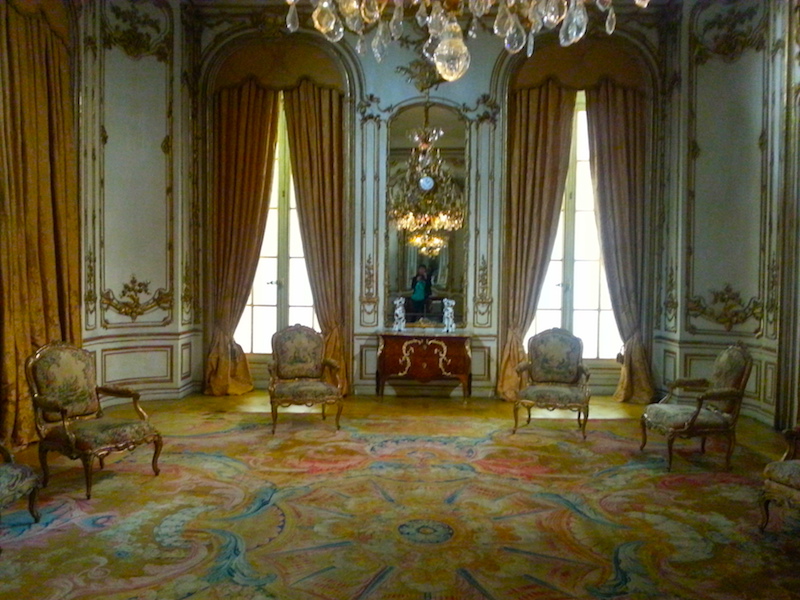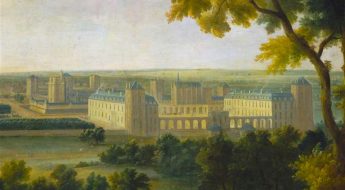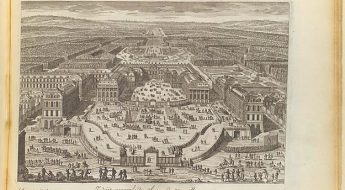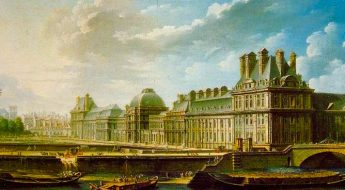
A Childhood at Versailles consists of the first 5 chapters of the memoirs of Mme de Boigne (1781-1866), née Adèle d’Osmond, who was a French salon hostess and writer. She was born in the Château de Versailles and lived at the court of Louis XVI and Marie-Antoinette until her family fled to England during the Revolution. Later in her long life, she married a rich soldier of fortune 30 years her senior, hosted a brilliant salon in Paris, and became an intimate of the last French queen, Marie-Amélie, consort of King Louis Philippe (r. 1830-1848). Childless herself, Mme de Boigne addressed her memoirs to her grandnephew. The memoirs were not published until 1907, under the title Récits d’une tante, or An Aunt’s Tales. They’ve never been published in English, as far as I know, so I’ve decided to translate the first 5 chapters, the ones that take place mainly at Versailles, and post them here on this blog for interested readers to enjoy for free.
The chapters are quite lengthy, so I’ve broken each one into several parts. In Part 2.2, the author describes the urbane manners and mores of summer life in 3 great country houses: Hautefontaine, Frascati, and Esclimont. As far as I can tell, all 3 chateaux were casualties of the Revolution.
A Childhood at Versailles, Chapter 2 (Part 2.2)
During the first years of my parents’ residence at Versailles, they divided their summer between the homes of the Duc d’Orléans, Saint-Assise and Raincy, Hautefontaine, which belonged to the Archbishop of Narbonne, the Bishop of Metz’s Frascati, and the Maréchal de Laval’s Esclimont.
I am wrong to say that Hautefontaine belonged to the Archbishop of Narbonne; it belonged his niece, Mme de Rothe, daughter of his sister, Lady Forester. She was the widow of a General de Rothe. She had been pretty enough and despotic with it, and did the honours of the house for her uncle, with whom she lived for many years in a highly complete intimacy that they hardly bothered to dissimulate.
The Archbishop had eight hundred thousand in revenue from his clerical benefices. Every two years he went down to Narbonne for a fortnight, and then presided over the Estates at Montpellier for six weeks. Throughout these times, he led a grand and very episcopal life, and deployed a fair amount of administrative capacity in presiding over the Estates. However, the day that the sessions ended, he packed up his papers and never gave them another thought until the next sessions opened, nor did he give any further thought to the needs of his diocese.
Hautefontaine was his customary residence. Mme de Rothe was its proprietor, but the Archbishop was the master. He had married his nephew, Arthur Dillon, son of Lord Dillon, to Mlle de Rothe, an only daughter and his grand-niece. She was a very pretty woman, very fashionable, one of the Queen’s ladies, and openly had a liaison with the Prince de Guéméné, who spent his whole life at Hautefontaine. In a nearby village, he had installed a hunting establishment, which he possessed in common with the Duc de Lauzon and the Archbishop, for whom his nephew, Arthur, served as the front.
There were always a lot of people at Hautefontaine, and there was hunting three times a week. Mme Dillon was a good musician; the Prince de Guéméné used to bring in the most famous virtuosi of the time, and excellent concerts were given. Plays were put on, there were horse races, and in short there was every kind of amusement.
The tone was so free that my mother told me she was often so embarrassed by it that she wanted to cry. In the first years of her marriage, she was so much the butt of sarcasm and jokes that it frequently made her quite ill, but the Archbishop’s patronage was too valuable to the young couple not to put up with it. A tall old vicar, for there were such among that worldly crowd, seeing her very sad one day, said to her: “Madame la marquise, don’t be upset; you are very pretty, which is already a shortcoming, yet you’ll be forgiven for it. But if you want to live peacefully here, make an effort to hide your love for your husband — conjugal love is the only kind not tolerated here!”
It is certain that all the other kinds were free to find expression. Nonetheless, there were certain polite conventions, by which no one was fooled, but which one could not omit without losing one’s reputation, as it was called then. There were established protocols, and one would have had to be a very grand lady indeed, or to have fashioned a unique position for oneself either by impudence or by superior skill, not to observe them. Mme Dillon was not in one of those categories, and she deployed such good manners in her moral disorder that my mother often said to me, “On arriving at Hautefontaine, one was sure that she was the Prince de Guéméné’s mistress, but after six months one doubted it.”
On the whole, actions in that company were as chaste as words were not. A man who placed his hand on the back of an armchair occupied by a lady would have seemed grossly insolent. It required a great deal of intimacy to link arms while out walking, and it hardly ever happened, even in the country. Never was a hand or an arm held on the way into dinner, nor did a man ever sit on the same sofa as a woman, but in contrast speech was free to the point of licentiousness.
At Hautefontaine, out of respect for its master’s position, one went to Mass on Sundays. No one took along a prayerbook, however; it was always volumes of frivolous works, and often scandalous ones, which were left in the chateau’s pews for the inspection of the furniture polishers, who were free to edify themselves by reading them.
I have entered into these details on the subject of Hautefontaine because I know them for certain. I do not pretend to say that all the archbishops of France led a similar life, but only that it could happen without being essentially prejudicial to esteem. All the grandest, most brilliant, and most fashionable people at Court, and all the most lofty and distinguished clergymen, did not miss the opportunity to go to Hautefontaine, and considered themselves honoured to do so. The Bishop of Montpellier (I do not know his family name) was the only who by his high virtue imposed on the Archbishop a little; when this bishop followed the hunt in his caleche, the Archbishop would say to his fellow hunters, “Well, now, gentlemen, we mustn’t swear today.” As soon as the heat of the chase got hold of him, he was the first to spur his horse and forget his own admonition.
In any case, our prelates were not the only ones in Europe who united sylvan pursuits with good living. Here is what Théodore de Lameth recounted to me just a few days ago.
In order to possess ecclesiastical benefices, knights of Malta needed to be tonsured. French bishops did not willingly perform this ceremony because favours granted to the knights took away a considerable part of the clergy’s property. Théodore de Lameth, being a knight of Malta and a cavalry captain at age twenty, had a good chance and an even stronger will to obtain a benefice. He was looking to be tonsured and was running into difficulties. Finding himself garrisoned at Strasbourg, he opened negotiations in Germany and for a modest sum persuaded the Prince-Bishop of Paderborn to render him the service that the bishops, his compatriots, refused to perform for him. The evening before the day that was fixed, he arrived at the Prince-Bishop’s residence in Paderborn. Champagne and happy chatter greeted the cavalry captain, which made for a very animated supper. The next day he presented himself in the church, in his uniform, which was partly covered with a cape draped so that his epaulette and counter-epaulette could be seen, and tucked up on on the hilt of his sword, while his surplice was folded over his arm. His hair, which in those days was usually worn knotted into a queue, was falling loosely over his shoulders.
He found the Prince-Bishop in front of the altar, surrounded by numerous clergymen. The ceremony proceeded with propriety, pomp, and magnificence. The Prince-Bishop seized a large pair of scissors with one hand and the entirety of the neophyte’s locks with the other. The young man trembled; he envisioned himself cropped in such a way that he would not dare to show his face at the garrison. But as the anthem played on, the Prince-Bishop let the hair slip between his fingers until only two or three strands remained, of which he cut off the ends.
At the moment that the ceremony coming to its climax, the newly tonsured young man knelt to receive the episcopal blessing, and was startled to hear these words spoken in a low voice at this most solemn moment: “Go take off your uniform and hurry over to my rooms; we shall take a cup of chocolate, and then we’ll go chase a roe.”
A fine conclusion worthy of the opening!
The story of this strange ceremony, very gaily recounted by an eighty-two-year-old man, seemed to me to recall in an amusing manner the mores of the time of my youth.
The Princesse de Guéméné, the governess of the Children of France, could not sleep away from Versailles without written permission from the King’s own hand. She never asked for it except to go to Hautefontaine. It was a consequence of the urbanity of morals that the wife was always particularly attentive to the woman chosen by her husband.
This brilliant but quite unepiscopal life was interrupted by Mme Dillon’s death and by a disruption in the Archbishop’s affairs. He found that he was crippled by debt despite his enormous income, and Hautefontaine was abandoned some time before the Revolution. My mother had not gone there as often since my birth. Children were not wanted there; it smacked too much of bourgeois family-mindedness.
Frascati, the residence of the Bishop of Metz, was situated at the gates of that large city. The Maréchal de Laval’s brother was the bishop at the time. He was passionately attached — in all honour — to his niece, the Marquise de Laval, who was a Montmorency like himself. He bored her to death loading her with attentions and presents, and she only consented to grant him the favour of going to reign over his magnificent residence of Frascati when my mother was able to accompany her. This she was all the more disposed to do during the few years that my father’s garrison happened to be in Lorraine.
The Bishop lived in great state and kept an open house for the immense garrison of Metz and for the superior officers who passed through on the way to their regiments. This ecclesiastical-military household was much more severe and regulated than that of Hautefontaine. Nevertheless, in order to conserve the tenor of the times, everyone knew that the Abbess of the Chapter of Metz and the Bishop had for some years had very strong feelings for one another, but this liaison, already of long date, ended up being regarded as nothing more than respectable.
My mother’s intimacy with the Marquise de Laval frequently took her to Esclimont, the home of her friend’s father-in-law, the Maréchal de Laval. All was calm there , and one led a family life. The old Maréchal spent his time making deplorable music, about which he was very passionate; his wife, perfectly good and indulgent, though very punctilious in her devotions, spent hers doing tapestry work. The Marquise de Laval,13 joined this domestic circle on leaving the Sainte-Marie convent school for girls. She had imbibed principles there that the commotions of the world distracted her from a little, but without altering her sentiments. She had attached herself with a limitless devotion to my mother, and through her to my father, to whom she was related; she was happy to rediscover with them the principles that she appreciated, with less boredom and rigour than at Esclimont, where this friendship was regarded with enchantment.
13. Marie Louise Mauricette Elizabeth de Montmorency-Luxembourg, Marquise de Laval, was Adèle d’Osmond’s godmother.
This concludes Part 2.2. In Part 2.3, we’ll learn more about the Prince and Princesse de Guéméné, as well as Mesdames, the aunts of Louis XVI, and their court-within-a-court.


















Leave a Comment